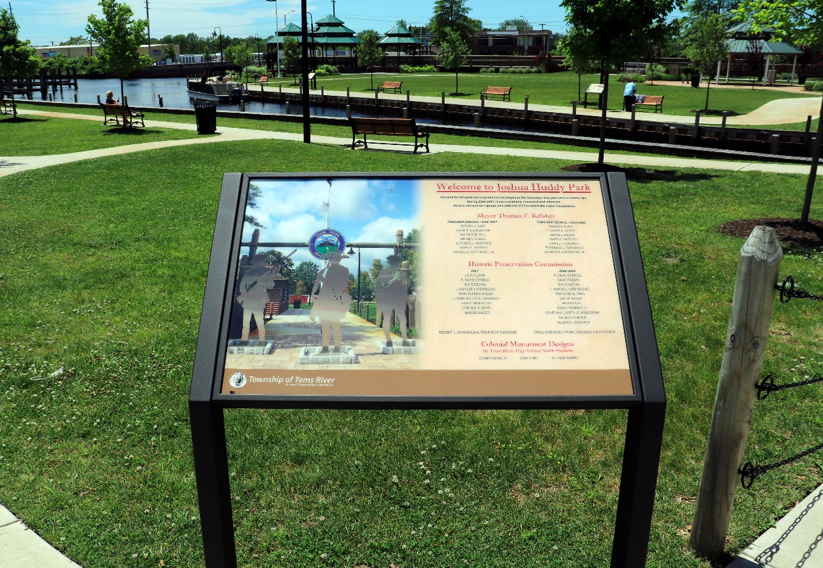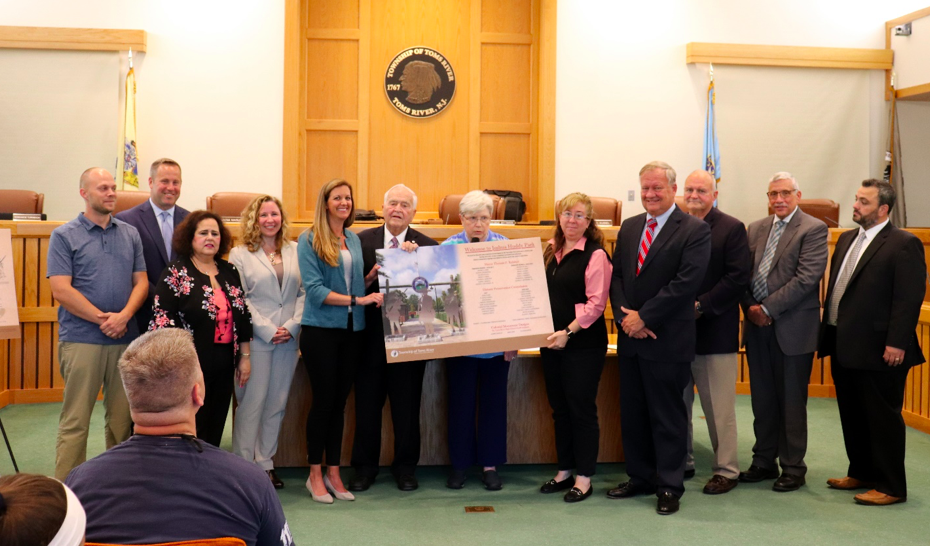
The first of five panels located in the park, the “Welcome to Joshua Huddy Park” sign greets visitors as they enter. (Photo credit: Stacy Proebstle)
American history unfolded out at what is now Huddy Park along the Toms River in 1782, when British and Loyalist ships entered the river via the now-closed Cranberry Inlet in Ortley Beach and attacked the growing fishing village which later became known as Dover Township (and, since 2006, has been named for the river itself).
Huddy Park, named for Revolutionary War hero Joshua Huddy, located downtown along the narrows of the river, was the township’s first park. But those who haven’t taken the time to research the history of the area may not be aware of what happened there. In an effort to strengthen residents’ knowledge of local history, five large gelcoat laminate panels were installed last week along a walking path in the park. The signs were built according to the National Park Service specifications.
The yearlong project was the brainchild of the Toms River Historic Preservation Commission who created the historic panels with the help of local graphic designer Jess Connors of Tortuga. The signs were manufactured by Pannier Graphics, located in Gibsonia, Pennsylvania.
The panels were presented during last Tuesday’s township council meeting.
There are six total panels, five of which, are located in Huddy Park. The panels take residents and visitors on a journey of the park’s history and include background on Toms River’s first municipal park, the Luker Bridge, how Huddy’s hanging stalled the peace talks in Paris and a panel on Captain Joshua Huddy himself.
“The signage tells about the British and Loyalists’ attack and near destruction in 1782 of the village of Toms River and the Pennsylvania Salt Works,” said Cynthia Smith, chairwoman of the Historic Preservation Commission. “The sixth and final panel describes the Pennsylvania Salt Works and will be located in Shelter Cove Park.”
“I’m so grateful for the work done by the Toms River Historic Preservation Commission,” said Mayor Thomas Kelaher. “The historic panels round out the finishing touches to the renovation of Huddy Park and help to educate the public on the earliest history of our town.”

Members of the Toms River Historic Preservation Commission present the new interpretive signage to the Mayor and Governing Body during the June 11th Council meeting. (Photo: Toms River Township)
Long before it was a park, the land was known as Gowdy’s Island. Starting in the 1890’s the owner of the land, Ralph B. Gowdy, began filling in the marsh using material excavated from the hill on Robbins Street. Over the following decade, the property adjacent to the river continued to be filled in despite warnings from the federal government. The property owners eventually stopped the illegal activity. Gowdy planned to sell the land for private development, but when he was unsuccessful, he sold it to the town in 1905 for $3,000 after residents of then-Dover Township voted to approve the acquisition. Shortly after, the island became the township’s first park and was called Gowdy’s Island.
Eventually the park was renamed to honor Captain Joshua Huddy.
Huddy was the commander of the Toms River Blockhouse when it was destroyed by the British in 1782. The township made modest improvements to the park in 1911 and acquired the adjacent land, which provided enough space to accommodate dockage for larger vessels. In 1915, interested residents collected roughly $600 to improve and beautify the park, including the construction of an octagon-shaped gazebo for band concerts.
Years later, the gazebo was restored due to age and weathering. A fire of undetermined origin destroyed it in 2010. During its more than one hundred years, the park grounds have been enhanced with trees, shrubs, flowerbeds and paths. More recently, a brick service building was added, which provides facilities for food preparation and public restrooms. Over the past century, the park has become a popular site for an occasional wedding and community happenings, including festivals, wooden boat shows, craft fairs, art shows, commemorative historical events.
In celebration of the township’s 250th anniversary in 2017, Huddy Park was completely renovated with new bulkheads, refurbished benches, gazebos and pathways, as well as fitted with decorative colonial soldier silhouettes, a town crier and enhanced illumination.


Police, Fire & Courts
South Toms River Man Charged in Violent Murder of Wife

Police, Fire & Courts
Toms River Man Sentenced to Prison for Assault, Eluding, Robbery, Threats






